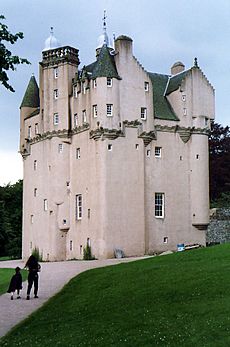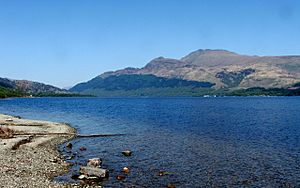National Trust for Scotland facts for kids
 |
|
| Formation | 1 May 1931 |
|---|---|
| Legal status | Trust |
| Headquarters | Broadstone, 50 South Gyle Crescent, Edinburgh EH12 9LD Scotland |
| Location |
|
|
Membership
|
326,000 |
|
Key people
|
Jackie Bird (President) Sir Mark Jones (Chairman) Philip Long (Chief Executive) |
|
Staff
|
617 full-time equivalent 1,144 Total |

The National Trust for Scotland (NTS) is a special charity in Scotland. It works to protect and share Scotland's amazing history and beautiful natural places. It is the biggest membership group in Scotland.
The NTS looks after about 130 properties and a huge amount of land. This includes old castles, small historic homes, gardens, coastlines, mountains, and countryside. It's like the National Trust in England, Wales, and Northern Ireland, but just for Scotland.
Contents
History of the Trust
The National Trust for Scotland started in 1931. It was first called the "National Trust for Scotland for Places of Historic Interest or Natural Beauty." The idea came from discussions at Pollok House.
The first president was John Stewart-Murray, 8th Duke of Atholl. The first chairman was Sir Iain Colquhoun. Sir John Stirling Maxwell, who owned Pollok House, gave the Trust its first property, Crookston Castle. Soon after, in 1935, they also bought Glen Coe with help from the Scottish Mountaineering Club.
| National Trust for Scotland Order Confirmation Act 1935 | |
|---|---|
| Act of Parliament | |

|
|
| Long title | An Act to confirm a Provisional Order under the Private Legislation Procedure (Scotland) Act 1936 relating to the National Trust for Scotland. |
| Citation | 26 Geo. 5 & 1 Edw. 8. c. ii |
| Territorial extent | Scotland |
| Dates | |
| Royal assent | 10 December 1935 |
| Text of statute as originally enacted | |
In 1935, a special law called the National Trust for Scotland Order Confirmation Act 1935 was passed. This law gave the Trust the power to make its properties "inalienable." This means the properties are protected forever and can only be sold or removed with special permission from the Scottish Parliament.
When the Trust started looking after mountain areas, there were some disagreements. Some people thought that visitor centers built in these wild places didn't fit in. Because of this, the Trust later moved some of these buildings. For example, the original Glen Coe Visitor Centre was moved in 2002 to a lower spot in the glen. The visitor center at Ben Lawers was also moved in 2012.
In 2010, a report called Fit For Purpose suggested ways the Trust could improve. The Trust made changes to its organization, which helped it become stronger financially. This allowed them to buy Alloa Tower in 2015, their first new property in seven years.
Historians working for the NTS have found that at least 36 of the 139 historic properties owned by the Trust have connections to the Atlantic slave trade. Many past owners of these properties either directly or indirectly benefited from the ownership of enslaved people. Some also received payments from a law in 1837 that compensated slave owners. The Trust is working to acknowledge and share this part of history.
How the Trust Works
The National Trust for Scotland is a registered charity in Scotland. As of 2024, it had 1,144 employees, including seasonal workers. This is equal to 617 full-time staff.
The Trust's Patron is King Charles III. The President is Jackie Bird, and the Chief Executive is Philip Long OBE. The chairman is Sir Mark Jones.
Funding the Trust
For the year ending February 28, 2022, the Trust's total income was £49.3 million. This was an increase from the previous year. Most of their money came from membership fees (£14.7 million), activities like shops and cafes (£9.0 million), and money from investments (£5.3 million).
In the same year, the Trust spent £51.9 million. This meant they had a small spending deficit of £2.7 million. This was mainly due to the effects of the COVID-19 pandemic. The Trust put a plan in place to improve its finances. This plan helped them catch up on repairs and continue their important work of protecting places and helping visitors.
For the year ending February 29, 2024, the Trust's total income was £69.5 million. Their total spending was £75.9 million, resulting in a £6.4 million deficit. However, growth from their investments helped to balance this out.
Becoming a Member
If you become a member of the Trust, you get free entry to their properties. They also offer "Discovery Tickets" for visitors who want to visit for a shorter time.
Being a member also gives you free entry to National Trust properties in England, Wales, and Northern Ireland. Members of those organizations can also visit NTS properties for free. The Trust also has partner organizations in the United States and Canada. The Trust's magazine, which shares news and stories, is called Scotland in Trust.
The Trust relies on volunteers to help maintain its natural properties. Local groups of volunteers work on projects during weekends. The charity also used to organize "Thistle Camps," which were working holidays. These camps involved activities like fixing footpaths and removing unwanted plants like rhododendrons. However, Thistle Camps are currently not being offered. The program was paused in 2020 because of the COVID-19 pandemic.
National Trust for Scotland Properties
The National Trust for Scotland looks after many different types of places.
Historic Houses
The Trust owns 27 historic houses. These range from large castles like Culzean Castle and the House of Dun to smaller, more everyday homes like the Tenement House and Moirlanich Longhouse.
Gardens
The Trust is the biggest owner of gardens in Scotland. They have almost 70 gardens, covering a large area. These gardens show the full history of Scottish gardening. You can see medieval styles, Renaissance gardens at Culross Palace, 18th-century designs at Culzean Castle, and Victorian gardens at the House of Dun. They also have 20th-century plant collections at Brodick and Inverewe.
Coastline and Countryside

The Trust manages a huge amount of land in Scotland, making it the third largest land manager. This includes 76,000 hectares of countryside, 46 Munros (Scottish mountains over 3,000 feet), 8 national nature reserves, and over 400 islands. They also care for long stretches of coastline. Famous countryside properties include Glen Coe, Torridon, and Mar Lodge Estate.
The Trust has a Wild Land Policy to guide how they manage these natural areas. Their goal is to keep the land wild and undeveloped, while still allowing people to visit and enjoy it. These Trust sites are home to many different native animals. The Trust believes that almost 25% of Scotland's seabirds nest on its islands and coastal sites. This is about 8% of all seabirds in Europe! The Trust's countryside properties are also home to native mammals like red deer, pine marten, wildcat, and red squirrel.
Since 1957, the Trust has owned and managed the islands of St Kilda. St Kilda is Scotland's first World Heritage Site. It's special because it's the only World Heritage Site in the UK recognized for both its natural beauty and its cultural history. St Kilda and its surrounding sea stacks are home to over one million seabirds. They also have three unique animal species: the Soay sheep, the St Kilda field mouse, and the St Kilda wren.
Paintings and Sculpture Collection
Across all its properties, the Trust is responsible for looking after hundreds of thousands of objects. These include paintings, furniture, and old tools. The main goal of the Trust's art care is to show these collections and artworks in the historic places where they were originally made or bought.
Most Visited Sites
During the 2023-24 financial year, the Trust had 4.5 million visitors in total. About 1.8 million of these visitors were to countryside properties that are free to enter. The Trust believes the actual number is even higher because it's hard to count everyone in open areas.
In 2024, these were the 10 most visited properties:
| # | Property | Location | Visitors |
|---|---|---|---|
| 1 | Glenfinnan Monument | Highland | 546,377 |
| 2 | Gladstone's Land | Edinburgh | 380,402 |
| 3 | Culloden | Highland | 374,443 |
| 4 | The Hermitage | Perth and Kinross | 359,937 |
| 5 | Glen Coe | Highland | 359,653 |
| 6 | Newhailes | East Lothian | 304,111 |
| 7 | Culzean Castle and Country Park | South Ayrshire | 247,602 |
| 8 | Crathes Castle and Gardens | Aberdeenshire | 201,997 |
| 9 | Robert Burns Birthplace Museum | South Ayrshire | 198,115 |
| 10 | Killiecrankie | Perth and Kinross | 184,459 |
Images for kids
-
Crookston Castle in Glasgow was the first property acquired by the Trust.
-
Glen Coe, the Trust's first major land acquisition
-
Culzean Castle in South Ayrshire is one of the Trust's most iconic sites.
See also
 In Spanish: National Trust for Scotland para niños
In Spanish: National Trust for Scotland para niños
- List of National Trust for Scotland properties
- Historic Environment Scotland





